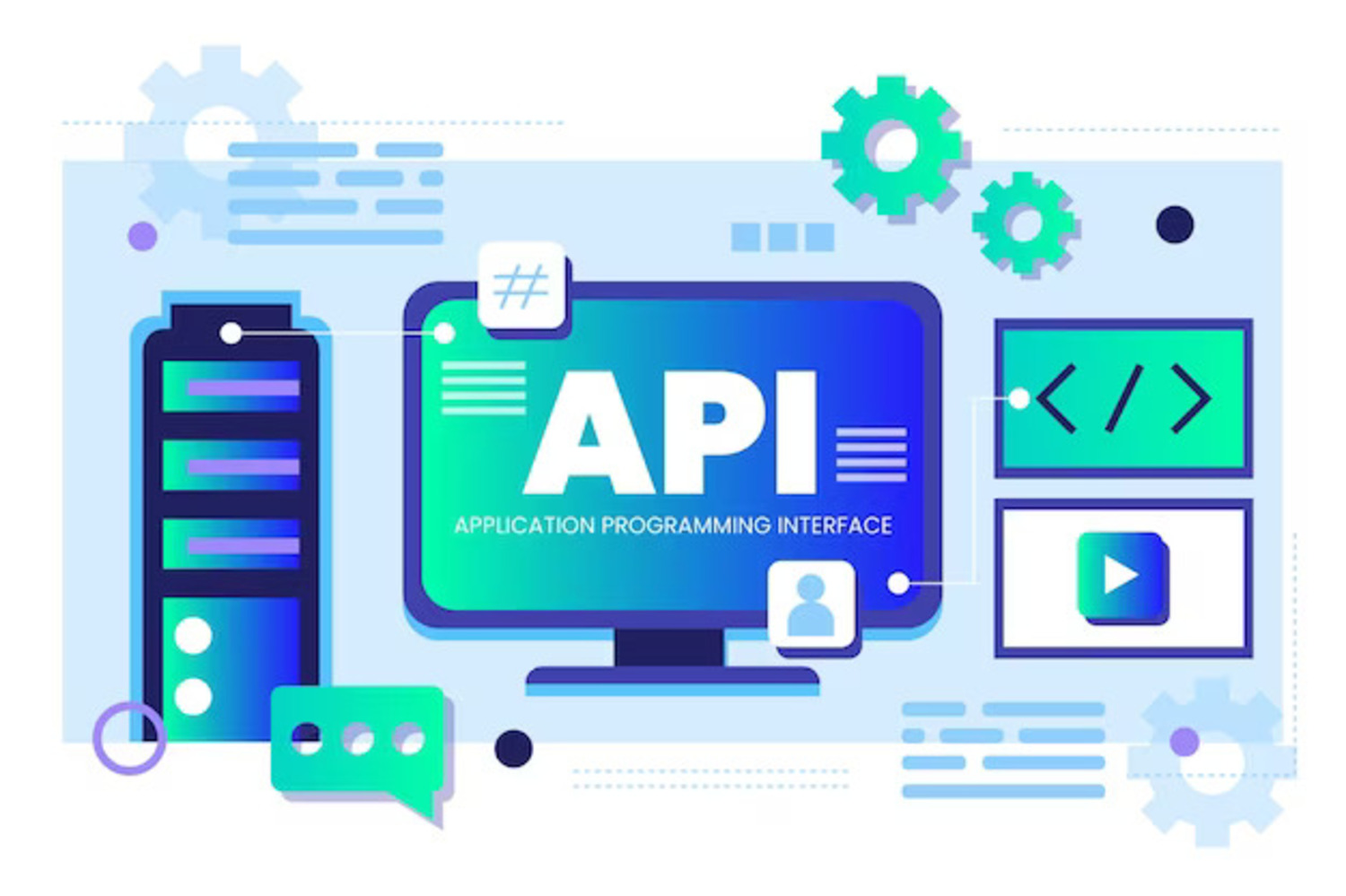

In simple terms, we explain how programs communicate with each other and practice API calls. You go to the site with vacancies and look for a job as a back-end developer, and almost every vacancy says that you need to be able to work with the REST API, SOAP API, or just API. What does all this mean, and why does a programmer need it? Let's figure it out.
What is API?
API (Application Programming Interface) is a set of ways and rules by which various programs communicate with each other and exchange data. All of these interactions occur through functions, classes, methods, structures, and sometimes constants from one program that others access. This is the basic principle of how the API works.
Let's say you buy a movie ticket with a bank card. During the purchase, the terminal accesses the API of the bank that issued your card and sends a payment request. And if you order a taxi through the application, it also accesses the payment system through the API.
The software interface is similar to the customer and seller contract. Only the client is an application that needs data, and the seller is the server or resource from which we take this data. Such an agreement prescribes the conditions for how and what data the client can receive.
The API is found almost everywhere:
- In programming languages, it helps functions communicate correctly with each other. The calling function must respect the data type and sequence of the parameters of the called function.
- An operating system helps programs retrieve data from memory or change OS settings. Therefore, you need to know its API to develop applications for a specific operating system.
- Services communicate through a programming interface on the web. If the API is open, then the creators of the source service publish the official documentation for working with it. So, for example, the Telegram documentation looks like this.
Even though the term is quite broad, most often in vacancies, we are talking about the third option.
Why is an API called an interface?
The interface is the boundary between two functional systems interacting and exchanging information. At the same time, the processes within each system are hidden from each other.

Using the interface, you can use the capabilities of different systems without thinking about how they process our requests and what they have “under the hood.” For example, knowing how the smartphone handles pressing the touchscreen is unnecessary for making a call.
The only important thing is that the gadget has a “button” that always returns the same result in response to specific actions. Similarly, you can perform certain program functions using API calls without knowing how it works. That is why API is called an interface.
What is a Video API?
A video streaming API is designed to access a platform. Video APIs support a wide range of functionality to create, customize, and control workflows from encoding to playback.
This allows developers:
- Insert video into the system;
- Process this video;
- Configure security options;
- Deliver content to end users;
- Manage recorded assets;
- View analytics throughout their workflow.
While many video platforms also provide management capabilities through a user interface, this format does not offer the same level of control and customization as an API. User interfaces often restrict developers to pre-built tools and vendors, limiting access to more advanced settings.
For example, your video content management system ( CMS) may come with simple analytics, but what if you prefer more advanced information?
With an API, you can choose external services and functionality to integrate into your application, which means you are not tied to the specific analytics tool offered. API access to the raw data also allows you to customize how the analysis is presented.
How does the API work?
The structure of the interface is usually viewed from the perspective of the client and the server. The program that makes the request is called the client, and the program that sends the response is called the server. You can draw an analogy with the weather forecast.
In this case, the information base of the meteorological company will be the server, and the browser that displays the results will be the client.
SOAP API
We can term it a "simple object access protocol." The exchange of information between the program and the server is in the XML language. It is rarely used today, as more flexible interfaces exist.
RPC API
Remote procedure call. The client requests the necessary action from the server and receives a response, which causes the application function to be executed.
WebSocket API
Another modern web version. The JSON text format sends information to a client or server. A feature of this API variant is that the server can send callback messages, increasing program interaction efficiency.
REST API
Today, it is the most requested version. The program sends the necessary information to the server, which in turn executes the built-in functions and sends the final data to the client.
APIs differ in structure and purpose of use. You should choose such an API so that its specifics correspond to your task.
- Private: They are part of the companies' systems and work only in them.
- Public: They are freely available and can be used by any Internet user. But among them, there are also paid options that preserve the confidentiality of data.
- Affiliate: This type can only be used by programmers who help organizations collaborate. A personal account is also provided.
- Composite: This option implies the work of different APIs when the developer faces a challenging task.
Composing a Set of Functions in APIs of an Application
A software interface's functions are set by a specialist when it is created. Before choosing an API, you need to consider three indicators:
- Features and capabilities of the client.
- The information needed to call the function.
- The software will receive data from the server by interacting with the API.
The user receives one or more hidden functions that process and issue program information. All workflows remain invisible to other people thanks to encapsulation. Software interfaces from the inside can be very different from each other.
There are, of course, specific standards accepted among developers. But by and large, a programmer in writing code is not limited by anything.
Some specialists in the general set assign functions responsible for registration and entry into the system. Others combine several tools that allow you to integrate a site into someone else's application or other web resources. And someone is used to grouping APIs. For example, functions for connecting a card - in one set and for working with payment - in another.
If you add everything to one group, the end user of the API will have the opportunity to choose on their own how to use the available functionality.
Why is API actively used in programming?

Programming interfaces help you work more productively.
Encapsulation, for example, makes web development much more accessible. Some of the necessary components are already contained in the API. Thus, there is no need to understand the code of elementary functions. At the same time, this helps to ensure the safety of the program's functionality, excluding the human factor. This is best seen in large-scale projects such as Windows or Linux.
How the API helps to write reliable programs?
Usually, we need to learn how programs work internally. However, we sometimes do not care how they work. Therefore, the software implementation is called a “black box” and is hidden behind several levels of abstraction to make it convenient for users to use them.
Abstraction layers significantly speed up the development process because the programmer can use ready-made API functions in other applications. This is standard practice. For example, most operating systems expose their APIs to other programs so that they can:
- Work with the file system,
- Draw graphics
- Store data,
- Use networking opportunities,
- Play audio, and so on.
Windows, Linux, or macOS determine which functions to call and which parameters to pass to perform specific actions. All this is described in the documentation for the API, which developers of other programs work with.
If some cloud computing API becomes faster at extracting the square root, then all programs using it - from online calculators to neural networks - will also start to work faster.
Why are APIs so popular with programmers?
APIs of services and libraries allow developers to stay at the wheel. Why write code when you can use ready-made?

Here are the possibilities provided by the API:
- For example Teyuto API assists in publishing video on demand and live streaming to any screen, globally. It is extremely helpful in building web and mobile video platforms.
- Increases security: The API allows you to move functionality that must be protected into a separate application. This reduces the possibility of incorrect use of these functions by other programs.
- Links to different systems. You can only do this with the API if you need to connect a payment system or authorization through social networks to the site.
- Reduces development cost: Using a paid API is often cheaper than creating functionality from scratch.
A third-party API is usually safe because a commercial organization or a whole community of developers is working on it. And, of course, with its help, even working on complex projects becomes more accessible and more enjoyable.
What functions can be included in the API?
There are no special rules or restrictions on the set of functions for the API. Developers include methods useful for client applications to interact with their service.
For example, the text analysis API will have functions to search for all cognate words, count the number of unions, and identify frequently occurring phrases. API functions can solve more than just the practical tasks of specific applications. This can become a marketing element when API access is offered separately.
How do companies make money with APIs?
Companies—especially those developing complex applications—often provide customers access to their product APIs. For example, video editor creators may charge extra for rendering videos on their servers.
What is the API used for?
The software interface allows developers to:
- Simplify and speed up the release of new products, as you can use ready-made APIs for standard functions;
- Make development more secure by bringing several functions into a separate application, where they will be hidden;
- Simplify the configuration of links between different services and programs and not cooperate with the creators of various applications to develop your product;
- Save money by not having to develop all software solutions from scratch.
Before the advent of Windows and other graphical operating systems, programmers had to write thousands of lines of code to create windows on a computer screen. When Microsoft released the Windows API to developers, creating windows took just a few minutes.
Business APIs are needed to:
- Conduct transactions
- Integrate data flow with clients and partner systems
- Improve the safety of automated processes;
- Develop your own applications;
- To innovate, for example, when working with clients.
In the 1990s, an organization that wanted to launch a customer relationship management (CRM) system was forced to invest heavily in software, hardware, and people. Companies now use cloud services like Salesforce. API-level access to Salesforce functionality allows businesses to enable critical elements of CRM functionality, such as viewing customer history.
API governments can:
- Exchange data between departments
- Interact with citizens and receive feedback.
A person only needs to send a photo of a pothole on the road and an indication of geolocation to the city system.
Video API Examples in Our Life
E-Learning: Video APIs can be used to create interactive e-learning platforms that offer students a rich multimedia experience. By integrating video hosting and playback functionality, e-learning platforms can offer a variety of video-based courses, webinars, and tutorials that students can access anytime, anywhere.
Live streaming: Moreover, it can create live streaming platforms for sports events, music concerts, and other live events. With video APIs, businesses and organizations can stream live content to audiences worldwide with high-quality video playback, interactive features, and real-time analytics.
Video conferencing: We can use Video APIs to build video conferencing applications for remote meetings, interviews, and consultations. By integrating video hosting, recording, and playback functionality, businesses and organizations can offer their clients and employees a seamless video conferencing experience.
Authorization Buttons
Many sites have buttons to register through existing popular and social network accounts. This is possible thanks to the APIs of Google, Facebook, Apple, and Twitter.
What to Look for in a Video API?
When choosing a video API, you should look for a solution that meets your workflow needs first and foremost.

You should also ensure the API has complete documentation updated with any changes and a good set of examples to guide you through simple workflows, ideally written in multiple languages.
Specifically, you want to find a video API that offers:
- Comprehensive functionality across your entire video stream workflow, including live streaming, VOD, playback, and more. Your best bet is with an integrated video platform like Teyuto.
- Informative resources, including documentation, forums, and video tutorials, get you started quickly.
- Developer tools such as sample code, options, GitHub repositories, custom modules, and testing tools to streamline the process.
Try Core by Teyuto
Core by Teyuto allows you to deliver your videos securely, provide secure user-level access, manage metadata, and track all video sessions and views at the user level. You don't have to use different vendors.
Supported Languages
- Shell
- Node
- Python
- Ruby
- PHP
Teyuto offers a complete and ready-to-use video API and technology set.
Core by Teyuto allows developers to integrate a platform's video encoding and hosting capabilities into their applications, allowing them to upload, encode, and host video content without developing these capabilities.
It offers the following features:
- Upload Video
- Live Streaming
- Video Player
- Analytics
- CDN
- HSL Encryption & Signed URL
Final Remarks
Video hosting APIs are a powerful tool for developers and businesses to integrate video hosting functionality into their websites and applications. They offer a range of features, including video management, uploading, transcoding, playback, and analytics.


Enjoyed this read?